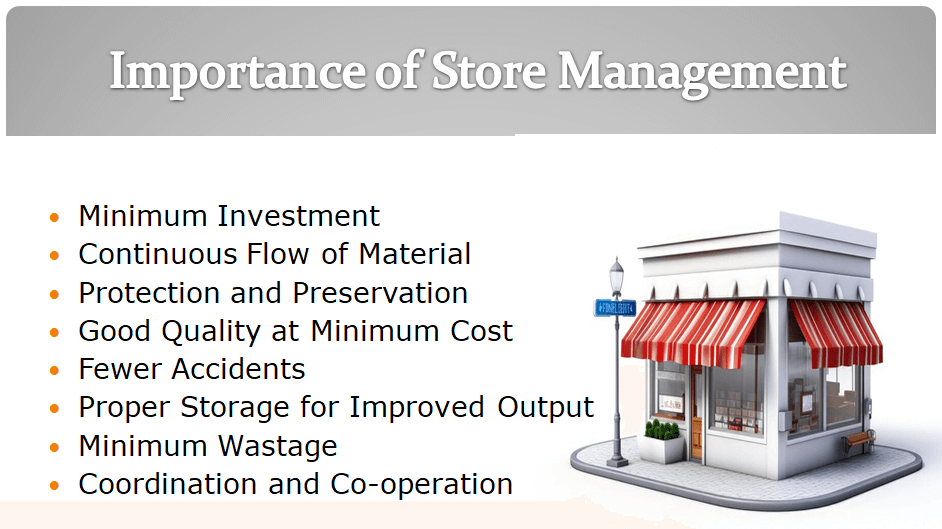Table of Contents:-
- Meaning of Store Management
- Definition of Store Management
- Objectives of Store Management
- Functions of Store Management
- Types of Store Management
- Centralized Store Management
- Decentralized Store Management
- Importance of Store Management
Meaning of Store Management
Store management refers to the efficient management of materials. Store management ensures that all the activities involved in storekeeping are carried out efficiently and economically by those employed in the store.
Stores form the basis of material management. Stores play a vital role in the seamless functioning of a company. In an organization, stores mainly aim to provide staff activity in producing goods or services. Industrial units or public undertakings of any size can only be managed efficiently with it. The primary objective of store management is to provide services to the operating functions in the most economical manner. Store management primarily includes the receipt, preservation, and issue of materials as and when required by user departments.
Definition of Store Management
According to Afford and Beatty, “Store management is that aspect of material control concerned with the physical storage of goods”.
According to Maynard, “Store management is to receive materials, to protect them while in storage from damage and unauthorized removal, to issue the materials in the right quantities, at the right time to the right place and to provide these services promptly and at least cost”.
Objectives of Store Management
The objectives of store management are as follows:
- Reducing Production Costs through Efficient Material Management
- Maintaining the Value of Materials
- Services to User Departments
- Advising Materials Manager
- Establishing Coordination with other Departments
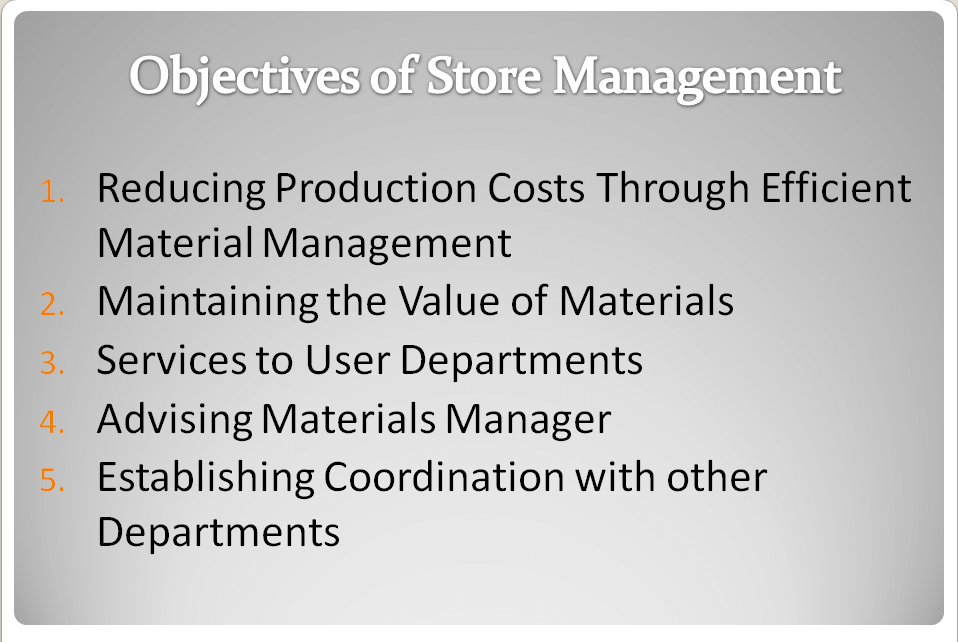 1) Reducing Production Costs through Efficient Material Management
1) Reducing Production Costs through Efficient Material Management
The primary objective of the store is to provide services most economically so that the production cost can be minimized. The cost of the material used in the production is the total cost of material, the cost of procurement, and the cost of carrying it in the store. The store costs include the cost of preservation, accounting, cost of insurance, and store equipment. These costs directly or indirectly affect the total product cost, which should be minimized.
2) Maintaining the Value of Materials
One of the objectives of a store is to maintain the value of materials in stock at the lowest practical level at all times to economize the working capital and minimize the cost of storage. The period of stay of each stock item is kept as short as possible, and efforts are made to avoid the inventory from becoming dead because redundant, obsolete, or surplus material is simply money sitting on a rack, requiring more money to be spent on its custody. Therefore, the store must maintain the value of store items.
3) Services to User Departments
Another objective of the store is to make available efficient services to the organization. These services include handling raw materials, work-in-process, finished goods, and scrap control.
i) To make available a smooth flow of raw materials, components, tools, equipment, and other commodities necessary to meet production requirements.
ii) To provide maintenance materials, spare parts, and general store as required.
iii) To receive and feed work-in-progress (items in the process of manufacture).
iv) To accept and securely store various scrap and discarded materials.
v) To account for all receipts, issues, inventory items, and stock goods.
4) Advising Materials Manager
The store is an integral part of materials management. That is why management has to rely heavily on the store department to formulate its investment policies. This objective can be achieved only if the store manager possesses a comprehensive understanding of both the store itself and the various items it offers. He can advise the materials manager on stock levels, quality, and quantity.
5) Establishing Coordination with other Departments
Coordination is the essence of effective management. Although the main objective of the store department is to keep the materials in touch with the material inventory control section, it does not mean that all other departments of the organization are to be ignored. To discharge its responsibilities adequately and efficiently, the store’s department must actively cooperate with other departments to provide service, have information, and maintain connectivity so that the service is efficient.
Functions of Store Management
The function of stores starts even before material moves in the inventory. It is in direct touch with the leading departments in its day-to-day activities. The most important purpose served by the stores is to ensure seamless service to the manufacturing divisions. Furthermore, stores are often equated directly with money, as money is locked.
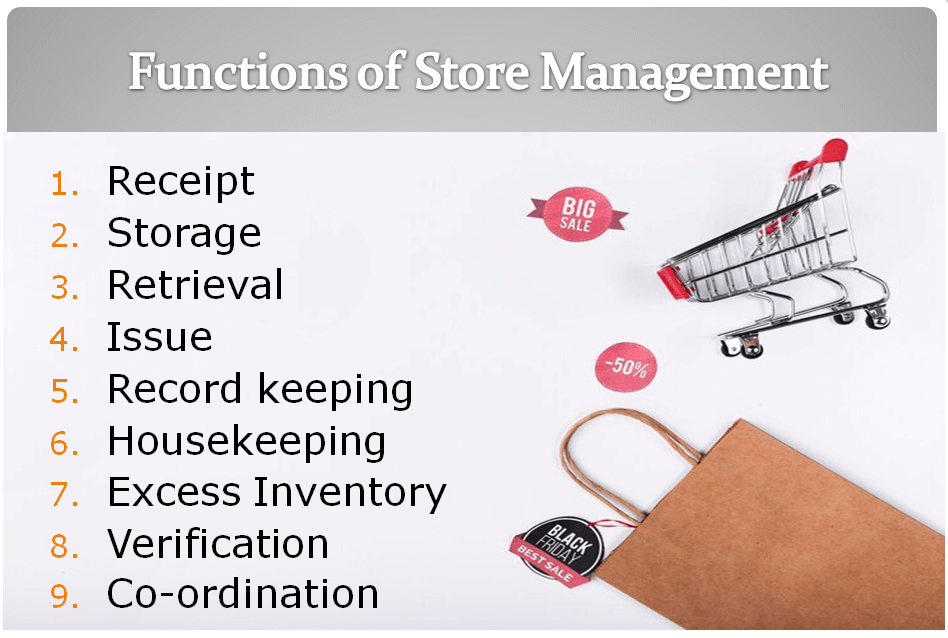
The functions of stores can be classified as given below:
- Receipt
- Storage
- Retrieval
- Issue
- Record keeping
- Housekeeping
- Excess Inventory
- Verification
- Co-ordination
1) Receipt: It receives and accounts inventories.
2) Storage: It stores and preserves the inventories, protecting them from pilferage, damage, and deterioration.
3) Retrieval: It helps easy accessibility to materials and ensures optimal utilization of space. It enables convenient location and retrieval of materials.
4) Issue: It satisfies the demands of consuming departments by properly issuing inventories and receiving the requisitions.
5) Record keeping: It records all issues and receipts accurately.
6) Housekeeping: The space is kept neat and clean so that material handling, preservation, storage, issue, and receipts are done satisfactorily.
7) Excess Inventory: Scrap and surplus disposal management is an essential function within inventory management.
8) Verification: Implementing physical verification and purchase initiation processes to avoid stock-outs.
9) Co-ordination and Co-operation: Interacting with the production and inspection department.
Types of Store Management
Depending on the scale and scope of operations, some items are stored separately based on their classification. For example, separate stores are essential for scraps, explosives, and chemicals. It is also possible to keep similar and related items together. For example, things like raw materials can be combined with items bought from outside. Machinery and equipment can be stored with jigs and fixtures because these are durable stores. Maintenance and consumables can be mixed and kept in one store. There is no hard and fast rule regarding the types of stores.
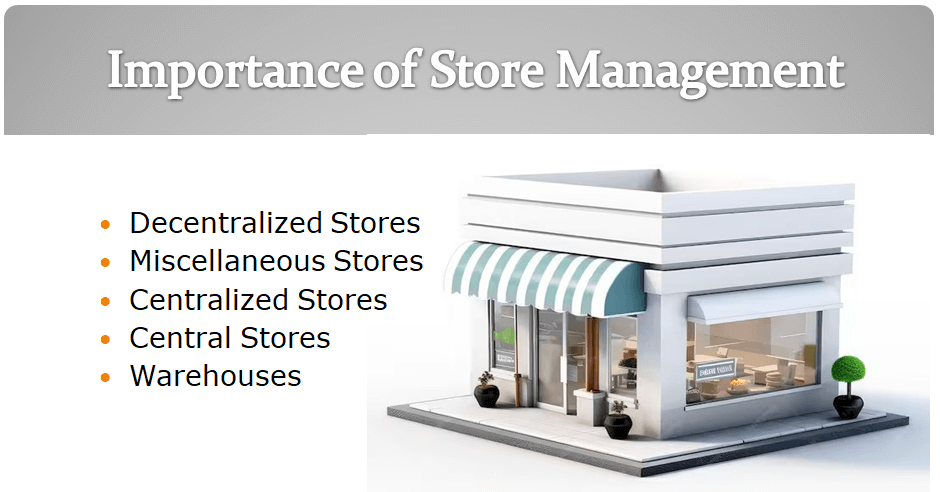
One such typical classification is given below:
1) Main or Centralized Stores
A central store is generally a ‘wholesale’ supplier to other units, departments, or sub-stores that operate on a retail basis, issuing goods directly to users. All materials are received and administered through a centralized store.
2) Branch or Decentralized Stores
Decentralized or branch stores are provided in considerably large plants and where one main store can only meet the requirements of the plast with waste of time and inconvenience.
3) Central Store with Sub-Stores
A giant factory with many product lines may have this type of storage system. A company has a central store that functions as a primary hub, accompanied by sub-stores dedicated to each production unit, preferably located as near the unit as possible. The sub-stores draw their requirements from the main store for a certain period, a fortnight or a month. This fixed material allocated to a specific department is called float or impress. After the completion of the determined period, the storekeeper of the sub-store will describe the material consumed and will issue a quantity of material equal to the material consumed to bring the level to the replenishment level. This system of giving and controlling materials is known as the periodic store control system.
4) Tool and Miscellaneous Stores
Tool and miscellaneous stores are equipped with all the tools the production and other shops need. The specific demands of the tasks at hand must diligently manage the inventory of tools. This store is responsible for issuing spare parts, tools, and other accessories to different departments. The devices are drawn from the main store once and then given by the stores as and when required by the departments. The main advantage of such a store is to relieve the main store from the burden of executing the retail requisitions of the departments. Regular tool inventory and issues should be monitored, and all worn-out and obsolete tools should also be accounted for. All those tools that are defective in any manner should be repaired before they are put in the racks.
5) Warehouses
Warehouses are the godowns that take the responsibility of keeping and storing goods and providing ancillary services to help small and medium-sized traders and manufacturers who, because of economic and technical reasons, may not like to have their storehouses. These warehouses preserve the goods scientifically and systematically to maintain their original value, quality, and usefulness. They charge a certain predetermined rental fee, which is charged at a fixed rate in advance.
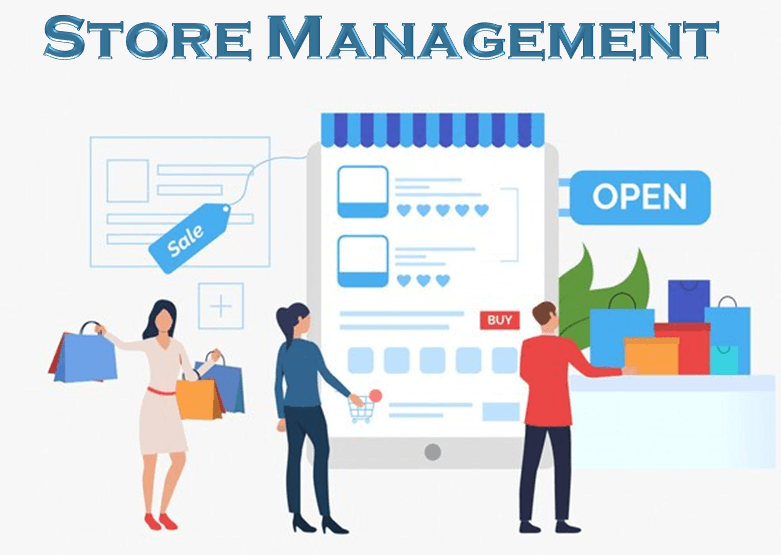
Centralised Store Management
A central store typically functions as a wholesale supplier to other units, departments, or sub-stores operating retail by directly providing goods to end-users. All materials are received and issued through a centralized store. Different departments need to purchase their requirements themselves. They ask for their material requirements for the central stove, and the material flows out of the store.
The main functions of the central store are given as follows:
1) To issue the material to branch stores and other departments.
2) To take steps for the replenishment of stock.
3) To receive all the tools, materials, and equipment.
The main store should be under the charge of a store officer. The storekeeper and his assistant would do the actual handling of the store. Thus, the main store acts as a reservoir of supply.
Although centralization, i.e., having all the stores in a central place, helps in better control and reduces the workforce, it creates difficulties in rendering services to various shops if they are scattered. It also increases materials handling problems. Centralization is suitable for small-scale operations; however, it is essential to classify different stock rooms effectively in such cases.
Advantages of Centralized Store Management
The advantages of the centralized store are as follows:
1) Various goods can be supplied to all users from one location.
2) Minimum inventory will be there as the store will have limited capacity, especially the tools, fixtures, large parts, and spare parts.
3) A smaller workforce will be required.
4) Better control of materials is possible.
5) Materials located in small available space ensure economy in storage.
6) Large inventories need to be there.
7) Receipts and inspection of materials can be efficiently organized.
8) Materials handling will be easy.
9) Deterioration and waste of materials will be reduced.
Disadvantages of Centralized Store Management
The disadvantages of centralized stores are as follows:
1) It may not be appropriate for significant manufacturing concerns.
2) More staff will be required to shift and transport the materials to various production units.
3) Shortage and waste of materials may be there.
4) Safety and maintenance of large materials are difficult in large stores.
5) Record keeping is difficult.
Decentralized Store Management
Decentralized or branch stores are provided in considerably large plants, where one main store can only meet the plant’s requirements, saving time and inconveniences. Different departments have their stores from which they can meet their material requirements. The limitations of centralized storage are removed with the help of decentralized storage, but because of high cost, these are not popular.
Advantages of Decentralized Store Management
The advantages of the decentralized store are as follows:
1) Reduced material handling and associated costs.
2) There are fewer chances of bottlenecks and delays.
3) Less risk of loss by fire or theft.
4) It is convenient for every department to draw materials.
5) Less transportation time.
Disadvantages of Decentralized Store Management
The disadvantages of decentralized stores are as follows:
1) Duplication in the storage of common parts results in higher overall inventory costs.
2) Labour utilization may suffer due to low store activity levels.
3) Duplication of clerical and accounting functions and computer equipment.
4) Coordination and control of all decentralized stores is a management challenge.
Importance of Store Management
Some of the benefits that flow from the excellent store are as follows:
- Minimum Investment
- Continuous Flow of Material
- Protection and Preservation
- Good Quality at Minimum Cost
- Fewer Accidents
- Proper Storage for Improved Output
- Minimum Wastage
- Coordination and Co-operation
1) Minimum Investment
The impact of Material costs on the total cost is immense. A sound storekeeping system helps to determine the levels of material, namely, minimum, maximum, and reorder levels. Thus, investment can be made at the required material level, and the extra capital can be utilized for other profitable purposes.
2) Continuous Flow of Material
Stores ensure a continuous supply of materials to the various departments without any delay and without causing any stoppage in production activities. This enables the company to maintain its production schedule.
3) Protection and Preservation
A store is meant to physically store materials scientifically and systematically to save them from all kinds of damages and losses.
It involves not only their custody or safekeeping but also their preservation against deterioration. Protection consists of the use of protective coating and appropriate storage methods. Thus, stores protect and preserve the quality and value of materials.
4) Good Quality at Minimum Cost
Today, in a cut-throat competition, every organization aims to produce quality goods at a low cost. Here, the race of the store’s department becomes very important. Fewer defectives mean increased production and lower price per piece produced.
5) Fewer Accidents
The stores should have a proper layout to avoid accidents resulting from unsafe conditions and acts. If the store’s design is not planned correctly, there will always be the fear of accidents. But a good layout will move with fewer accidents and less breakage of materials.
6) Proper Storage for Improved Output
Keeping things in an appropriate place is conducive to a good workflow. As a result of the improved workflow, the cycle time is reduced, and output is increased.
7) Minimum Wastage
Stores keep the storekeeper continuously informed about the actual position of materials. Therefore, counting the various items is unnecessary, which saves time and money. There is also less loss of materials by theft, malpractices, or pilferage and minimum wastage during handling. All this helps in reducing all kinds of waste in materials.
8) Coordination and Co-operation
The store management helps an organization run smoothly by actively cooperating with other departments. It provides services to the different departments and gives and receives information to make that service efficient.
You May Also Like:-

